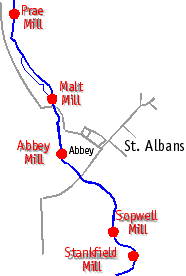In medieval St Albans, the cloth trade was of considerable economic importance. Some of the manufacturing processes took place in Fullers Street (now the vehicular access to the Westminster Sports centre, aka Mud Lane) which then lay outside the town. Chris Saunders explains how historical records shed light on the scale and range of manufacturing activities.
The present Mud Lane by Westminster Lodge sports centre was known as Fullers Lane in the seventeenth century. This seems to have been the Fullers Street of medieval times.
The tenterground
In 1266 a plot of land in this street was said to adjoin the tentorium – tenterground (a place where fulled cloth [1] was hung out to dry) of Richard son of Robert. In the same year Alexander Goldstob granted to his daughter Emma, for ten shillings a messuage [2] and three particate (?enclosures) of land and two tentoria in the Fullers Street, paying yearly 1/2d to herself and 4d to the Nuns of St. Mary at Sopwell and 4d to the heirs of John Woolmonger (lanovii).
The Abbey’s mills and its control over fulling
In the Domesday survey of 1086, three mills are recorded at St. Albans, although exactly which these were is uncertain. The mills did not only grind corn, there was also a malt mill and a fulling mill.

Probable location of medieval mills on the River Ver
Sopwell Mill must have been on or near the site of the existing mill, mentioned in 1381 with its Flotegatestrem and Mullestrem.
Stankfield Mill was further downstream towards the site of the post medieval New Barnes Mill. Both these were so named in 1119-46 when, along with 2 mills of Park, they provided eels for the Abbey kitchen. These were perhaps two of the three mills recorded in Domesday Book in 1086, the other being the Malt Mill (or the Abbey Mill?) Stankfield Mill was rebuilt in 1326-35.
In 1274 Henry de Porta had illegally set up a fulling stock in his house in Fullers Street – cloth had to be fulled at the Abbey fulling mill. The cloth trade was of great local importance.
In 1355, 11 weavers, 5 fullers and 2 dyers were recorded as having infringed regulations. In the reign of Edward II (c. 1360) there were11 weavers, 6 fullers and 5 dyers. The weavers produced broadcloth, (a cloth 2 yards by 48 yards). In 1395 there were 27 producers, the four most prolific producing 15, 10, 5 and 5 cloths. In 1341, 11 men and women held a stock of 15 stone of fleeces. (At St. Mary de Prae in 1342-3, 6 fleeces were sold for 2s 2d at the rate of 87 to 15 stone).
Fulling was not the only activity carried out in this street. In c.1276 Richard of Waltham, a glove maker, held a messuage here with pasture, land and one vineyard.
[1] Fulling is a step in woollen clothmaking which involves the cleansing of cloth (particularly wool) to eliminate oils, dirt, and other impurities, and to make it thicker. By the medieval period, fuller’s earth was used in the process, replacing human urine.
[2] Messuage – a dwelling house with outbuildings and land assigned to its use (OED)




